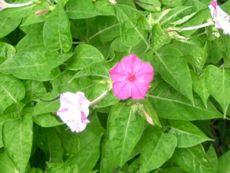Mirabilis
| Mirabilis subsp. var. | ||||||||||||||||||||||||||||||||||||||||||||||||||||||||
|---|---|---|---|---|---|---|---|---|---|---|---|---|---|---|---|---|---|---|---|---|---|---|---|---|---|---|---|---|---|---|---|---|---|---|---|---|---|---|---|---|---|---|---|---|---|---|---|---|---|---|---|---|---|---|---|---|

|
|
| ||||||||||||||||||||||||||||||||||||||||||||||||||||||
| ||||||||||||||||||||||||||||||||||||||||||||||||||||||||
| Standard Cyclopedia of Horticulture |
|---|
|
Mirabilis (The old name was Admirabilis, meaning wonderful, strange; shortened by Linnaeus to Mirabilis). Nyctaginaceae. Interesting flower-garden herbs. The fls. have no corolla, but the calyx is colored and tubular and exactly like a corolla in appearance. The fls. are surrounded by a leafy involucre, and sometimes (as in M. Jalapa) only 1 fl. is borne in an involucre, simulating a corolla in a 5-cleft calyx; stamens 5 or 6, as long as the perianth, their filaments united at the base; style 1, with a capitate stigma: fr. hardened, caps.-like and indehiscent.—About a dozen species in the warmer parts of Amer.; or twice that number if Oxybaphus is included. The species of Mirabilis are perennial herbs, although grown as annuals from seeds, with lvs. petioled and opposite, and fls. solitary or paniculate and nearly or quite sessile in the involucres.
|
| Mirabilis {{{status}}} Fossil range: {{{fossil_range}}}
| ||||||||||||||||||||||||||||||||||||||||||||||||||||||||||||||||||
|---|---|---|---|---|---|---|---|---|---|---|---|---|---|---|---|---|---|---|---|---|---|---|---|---|---|---|---|---|---|---|---|---|---|---|---|---|---|---|---|---|---|---|---|---|---|---|---|---|---|---|---|---|---|---|---|---|---|---|---|---|---|---|---|---|---|---|
 Mirabilis jalapa | ||||||||||||||||||||||||||||||||||||||||||||||||||||||||||||||||||
| Plant Info | ||||||||||||||||||||||||||||||||||||||||||||||||||||||||||||||||||
| ||||||||||||||||||||||||||||||||||||||||||||||||||||||||||||||||||
| Scientific classification | ||||||||||||||||||||||||||||||||||||||||||||||||||||||||||||||||||
| ||||||||||||||||||||||||||||||||||||||||||||||||||||||||||||||||||
| [[{{{diversity_link}}}|Diversity]] | ||||||||||||||||||||||||||||||||||||||||||||||||||||||||||||||||||
| {{{diversity}}} | ||||||||||||||||||||||||||||||||||||||||||||||||||||||||||||||||||
| Binomial name | ||||||||||||||||||||||||||||||||||||||||||||||||||||||||||||||||||
| {{{binomial}}} | ||||||||||||||||||||||||||||||||||||||||||||||||||||||||||||||||||
| Trinomial name | ||||||||||||||||||||||||||||||||||||||||||||||||||||||||||||||||||
| {{{trinomial}}} | ||||||||||||||||||||||||||||||||||||||||||||||||||||||||||||||||||
| Type Species | ||||||||||||||||||||||||||||||||||||||||||||||||||||||||||||||||||
| {{{type_species}}} | ||||||||||||||||||||||||||||||||||||||||||||||||||||||||||||||||||
| Species | ||||||||||||||||||||||||||||||||||||||||||||||||||||||||||||||||||
| Mirabilis coccinea Mirabilis expansa | ||||||||||||||||||||||||||||||||||||||||||||||||||||||||||||||||||
| [[Image:{{{range_map}}}|{{{range_map_width}}}|]] | ||||||||||||||||||||||||||||||||||||||||||||||||||||||||||||||||||
| Synonyms | ||||||||||||||||||||||||||||||||||||||||||||||||||||||||||||||||||
| {{{synonyms}}} |
Mirabilis is a genus in the family Nyctaginaceae, perhaps the best know genus in the family. Its most famous species is Mirabilis jalapa, the Four-o'clock flower. Also see Mirabilis longiflora.
There are several dozen species in the genus, of herbaceous plants, mostly found in the Americas. Sometimes they have tuberous roots which enables them to perennate through dry and cool seasons. They have small, deep-throated flowers, often fragrant.
Although best known as ornamental plants, at least one species, Mirabilis expansa, mauka, is grown for food.